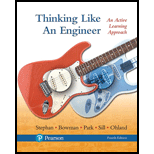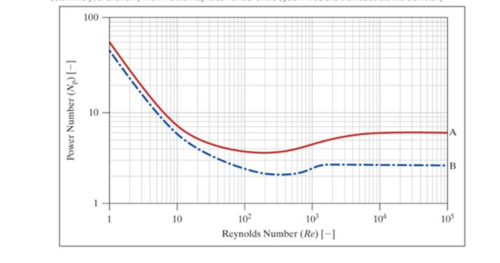
Concept explainers
The relationship of the power required by a propeller (show as the power number, on the ordinate) and the Reynolds number (abscissa) is shown in the following graph. For a propeller, the Reynolds number (Re) is written slightly differently as
where D is the blade diameter [meters] and n is the shaft speed [hertz]. The power number (Nρ) is given by the following, where P is the power required [watts].
Use the following chart to answer questions (a) through (d).
- a. If the Reynolds number is 500, what is the power number for a system described by curve A?
- b. If the power number (Nρ) is 30, what is the Reynolds number for a system described by curve A?
- c. If the Reynolds number is 4000, what is the power (P) required in units of watts at a shaft speed (n) of 0.03 hertz? Assume the system contains acetone, with a kinematic viscosity of 0.419 stokes. The density of acetone is 0.785 grams per cubic centimeters. Use curve B in the graph to determine your answer. (Hint: Use the Reynolds number of the system to first calculate the diameter, then find the power number, and then calculate the power.)
- d. If the power number (Nρ) is 5, what is the diameter (D) of the blade in units of centimeters at a shaft speed (n) of 0.02 hertz? Assume the system contains brine, with a kinematic viscosity of 0.0102 stokes. Use curve A in the graph to determine your answer. (Hint: Find the Reynolds number of the system first, and then calculate the diameter.)

Want to see the full answer?
Check out a sample textbook solution
Chapter 13 Solutions
Thinking Like an Engineer: An Active Learning Approach (4th Edition)
Additional Engineering Textbook Solutions
Fundamentals of Aerodynamics
Applied Fluid Mechanics (7th Edition)
Machine Elements in Mechanical Design (6th Edition) (What's New in Trades & Technology)
Mechanics of Materials (10th Edition)
Fluid Mechanics Fundamentals And Applications
Foundations of Materials Science and Engineering
- Completely solve and box the final answer. Please show the units to show the unit cancellations. Write legibly 2. During a steady flow process, the pressure of the working substance drops from 1,380 kpa to 138 kpa, the speed increases from 61 m/s to 305 m/s, the internal energy of the open system decreases 58.1 KJ/kg, and the specific volume increases from 0.0625 m3/kg to 0.5 m3/kg. No heat is transferred, determine the work in KW if the mass flow at the rate of 272.15 kg/hr.arrow_forwardFor the Following question Graph all 4 : [I just need all 4 graphs and please explain and make clean solution] Position vs time Velocity vs time Acceleration vs time Force vs time [For your convenience, I have solved the numerical solutions for the problem] (Please Look at the picture since it is much cleaner) Question : A 550 kilogram mass initially at rest acted upon by a force of F(t) = 50et Newtons. What are the acceleration, speed, and displacement of the mass at t = 4 second ? a =(50 e^t)/(550 ) [N/kg] v = ∫_0^t▒(50 e^t )dt/(550 )= v_0 +(50 e^t-50)/550=((e^t- 1))/11 x = ∫_0^t▒(e^t- 1)dt/(11 )= x_0 +(e^t- t - 1)/(11 ) a(4s)=(50*54.6)/550= 4.96[m/s^2 ] v(4s)=((e^4-1))/11= 4.87[m/s] x(4s)=((e^4- 4 - 1))/11= 4.51 [m]arrow_forwardStudy the table to the right and then answer these questions by filling in the blank columns in the table.1. Convert the miles per gallon figures in the table tokilometers per liter (kpl).2. How many liters (and how many gallons) of gasolinewould each type of car use annually if it were driven19,300 kilometers (12,000 miles) per year?3. How many kilograms (and how many pounds) of carbon dioxide would be released into the atmosphereannually by each car, based on the fuel consumptioncalculated in question 2? Assume that the combustion of gasoline releases 2.3 kilograms of CO2 per liter(19 pounds per gallon).arrow_forward
- PLEASE SHOW SOLUION STEP BY STEP WITH UNITS. PLEASE ANSWER IT IN 30 MINS. TOPIC: THERMODYNAMICS - PROCESSES OF GASESarrow_forwardThat is all the information they give me and X and Y there are on the grapharrow_forwardSearch and define the following:(write each required formula - define its variables) 1. Impulse and Momentum2. Work Energy Principle3. Law of conservation of momentumarrow_forward
- The velocity of the fluid flowing in a pipe with a radius of 10 cm was measured at certain points and the following table values were obtained. r=the distance of the measurement points to the center of the pipe (m) v=measured speeds (m/s) Accordingly, calculate the velocity value for r = 0.07 m by using 3rd order interpolation with the help of appropriate points that make the error minimum. In calculations, take 4 digits after the comma.arrow_forwardwhat's mean below sentence? i couldn't understand θm=θ1-θ2lnθ1θ2=Thi-Tco-Tho-TcilnThi-TcoTho-Tci=60-55-30-20ln60-5530-20=7.2135 °Carrow_forwardShown in the image is a vertical section of a 66 block grid of a gold mine deposit. Each block is identified with a number and a gold (Au) grade in g/t. As shown, most blocks contain non- valuable or zero ore-grade (G=0). However, the ore-grade of highlighted block #17 is G2= 1.4 g/t, and similarly the ore grades of blocks #28, #39, #50 and #61 are in turn: G3 = 1.2, G4 = 2.3, G5 = 2.8, and G6 = 2.9 g/t. Evaluate the mining methods (o/c or u/g) which should be selected based on economic considerations only.arrow_forward
- Please help answer the question shown in the photo. Please explain clearly why the formulas you picked were used, and what the purpose of each number and variable in your calculation represents. Thank you!arrow_forwardSuppose you're converting a bill of materials for machining feedstock from the British gravitational (U.S. system) of units to International System (SI) units. Your goal is to have all of the material quantities in kilograms. Your bill of materials lists values for required weights of brass rod in pounds. To convert to these values to kilograms you first you divide by gravitational acceleration in feet per second squared to get a mass in slugs, then convert slugs to kilograms using standard conversion factors. Group of answer choices True Falsearrow_forwardSelect the letter of the correct statement. Write the answer with calculations, drawing, rules or explanation 1-) Person (approximated as a cylinder of 50 cm diameter and 160 cm long) walks with a velocity of 1 m/s in air(y = 15*105 m2/s). If the person velocity was doubled, the rate of heat loss from that person by convection. A-) increases 2 times. C-) increases 1.7 times. B-) decreases 2 times. D-) increases 1.3 times E-) No Change.arrow_forward
 Elements Of ElectromagneticsMechanical EngineeringISBN:9780190698614Author:Sadiku, Matthew N. O.Publisher:Oxford University Press
Elements Of ElectromagneticsMechanical EngineeringISBN:9780190698614Author:Sadiku, Matthew N. O.Publisher:Oxford University Press Mechanics of Materials (10th Edition)Mechanical EngineeringISBN:9780134319650Author:Russell C. HibbelerPublisher:PEARSON
Mechanics of Materials (10th Edition)Mechanical EngineeringISBN:9780134319650Author:Russell C. HibbelerPublisher:PEARSON Thermodynamics: An Engineering ApproachMechanical EngineeringISBN:9781259822674Author:Yunus A. Cengel Dr., Michael A. BolesPublisher:McGraw-Hill Education
Thermodynamics: An Engineering ApproachMechanical EngineeringISBN:9781259822674Author:Yunus A. Cengel Dr., Michael A. BolesPublisher:McGraw-Hill Education Control Systems EngineeringMechanical EngineeringISBN:9781118170519Author:Norman S. NisePublisher:WILEY
Control Systems EngineeringMechanical EngineeringISBN:9781118170519Author:Norman S. NisePublisher:WILEY Mechanics of Materials (MindTap Course List)Mechanical EngineeringISBN:9781337093347Author:Barry J. Goodno, James M. GerePublisher:Cengage Learning
Mechanics of Materials (MindTap Course List)Mechanical EngineeringISBN:9781337093347Author:Barry J. Goodno, James M. GerePublisher:Cengage Learning Engineering Mechanics: StaticsMechanical EngineeringISBN:9781118807330Author:James L. Meriam, L. G. Kraige, J. N. BoltonPublisher:WILEY
Engineering Mechanics: StaticsMechanical EngineeringISBN:9781118807330Author:James L. Meriam, L. G. Kraige, J. N. BoltonPublisher:WILEY





